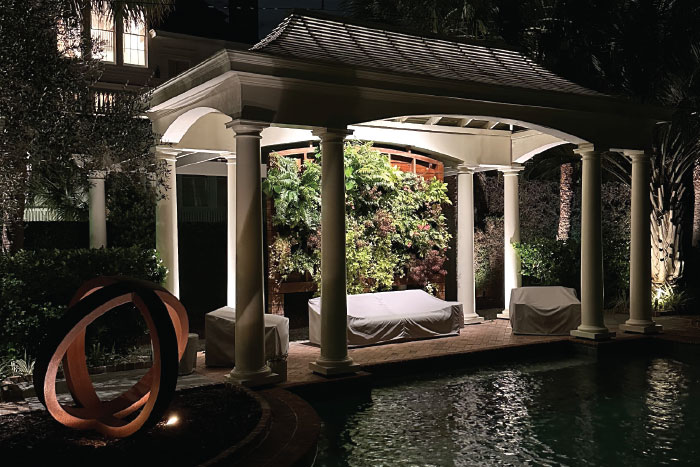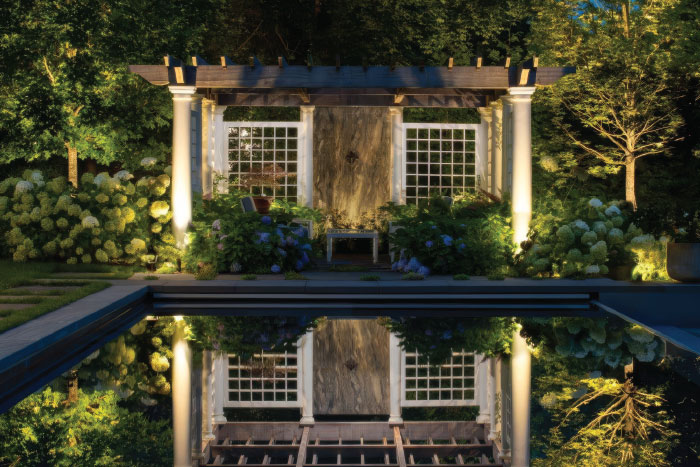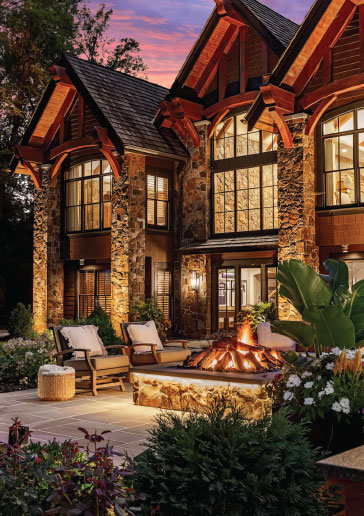As a professional outdoor lighting designer, illuminating residential landscapes with stunning, functional and budget-conscious designs wow clients and make their neighbors glow green with envy. Happy clients are your best advertisement, generating repeat business and referrals, while easy-to-install systems save time and strengthen a project’s bottom line. To prioritize client satisfaction in conjunction with efficient installations, Certified Outdoor Lighting Designers offer their best tips to make you the top choice in residential landscape lighting.

Get on the same page
Bridging the gap between client dreams and installation realities is key. Inspired by high-end portfolio images featured on outdoor landscape lighting websites, many clients come in with champagne tastes. To ensure a smooth experience, prioritize understanding their needs and desires early on, sometimes before the client even understands what they want. This way, you can tailor a stunning, functional outdoor lighting system that fits their budget and your installation capabilities.
“I prefer to think of the designer’s role as consultative [for the client],” says Michael Deo, CLVLT, COLD, president and lead lighting designer at NatureScape Lighting + Audio based in Long Hill, New Jersey. “We are not car salesmen trying to negotiate the lowest price with a prospective client. Instead, here’s what we can do, and here’s what we can do now that makes the most sense. In the end, you want to create a complete design.”
Landscape lighting is a deeply personal statement, and Anthony Bogdanovich, COLD, founder and general manager of California Outdoor Lighting, based in Harbour City, California, says successful outdoor lighting designers must focus on the homeowner, not just the property itself.
“How much lighting someone wants or needs is very subjective,” Bogdanovich says. “Someone more reserved might want something simple that identifies key focal points and addresses other needs like safety or security. Someone else might want to create a much bigger statement and want everyone to notice. It’s the same location, but two very different feels.”
Successful lighting pros design as much for the client as they do for the landscape they’re illuminating, and creating an agreeable plan involves asking questions and listening to what really interests them, says Greg Matthews, COLD, CLVLT, owner of Luxury Illumination, which has offices in Palm Beach, Denver and Nashville.
“When we meet with clients, we generally won’t ask what kind of lights they want to use [on a project],” Matthews says. “We want to know how they use their home, where the kids play, what they enjoy doing at night, and if they host a lot of social events.”
Consider asking questions that will help you better understand how the client connects with their yard. What features are special to them, like a memorial tree, a statue or a water feature, and how would they desire to have that better highlighted as a focal point in the landscape? After ascertaining these factors, design and present lighting ideas that positively affect the client’s life.
“Everyone has lighting, and even bad lighting is better than no lighting. Once you get to know your client, you can improve upon that, address what bothers them about the lighting they have in place and recommend [lighting options] that they didn’t even know they could do.”
– Greg Matthews, Luxury Illumination
“Everyone has lighting, and even bad lighting is better than no lighting,” Matthews says. “Once you get to know your client, you can improve upon that, address what bothers them about the lighting they have in place and recommend [lighting options] that they didn’t even know they could do.”
Since prospective clients may be talking to multiple design pros, asking them why they think a certain way about potential lighting issues with their property is essential. For example, a homeowner may point out a particular tree and say they want a single spotlight because that’s what the last two contractors told them, says Matt Carli, COLD, and the lead designer at Moonlighting Landscape Lighting Systems in Charleston, SC.
“If you use more lights in different ways, it will really bring out the best features that make that tree special,” Carli says.
Finally, those initial conversations also weed out the tire kickers, who waste a designer’s time and creative resources.
“A lot of [designers] learn this the hard way,” Deo says. To circumvent this, he suggests charging a minimal design fee of a few hundred dollars which is then applied to the final project. This separates the interested from the curious.
“I don’t charge for an initial phone consultation, but I do charge a design fee if it goes beyond that initial phone call,” Deo says. “If a client is not willing to pay $300 for a few hours of my time, then how are they going to pay thousands for an entire lighting project?”

Manage expectations
Outdoor lighting projects rarely come with blank checks, and a skilled designer bridges the gap between client expectations and cost realities. A hefty initial price tag can scare clients from committing to a lighting project. The key? Keeping them engaged as partners throughout the process.
Deo suggests a collaborative approach to developing a successful landscape lighting design that includes a first draft without a hard budget. Review that proposal with the client and get feedback on what they like and don’t like. This initial design becomes a springboard for a value-engineered plan that addresses cost concerns without compromising the overall vision or diluting intent.
“We’re always looking to do something a little bit unique that will set the project apart and that the client can really be proud of,” Deo says. “So, you’re trying to fit [the design] into the project budget, within the parameters of the [lighting fixtures] you’re using, and what can and can’t be done by your [installation] crews.”
Treating a lighting design as a phased project is one way to overcome sticker shock, Carli says.
“Treat the initial installation of landscape lighting as Phase one and focus on what can really make the environment special and an element or two that you can use lighting to make pop,” he says. “When done correctly, clients begin to get excited about how lighting transforms and enhances an environment, making them eager to pursue phases two and three.”
Outdoor lighting preferences are as unique as those who design and enjoy them. Many residential clients approach designers intending to enhance their property but lack a specific vision for how that can be accomplished with landscape lighting.
“It’s the lighting designer’s goal to get someone excited about their property in a way they may not have been in a very long time, or even at all,” Bogdanovich says.
The key lies in identifying the property’s focal points – those captivating elements that deserve attention. Once identified, the designer considers how to best illuminate the entire scene, creating a balanced composition that guides the eye toward these intriguing features.
“Balance is the most important principle of a [landscape lighting] composition,” Bogdanovich explains. “Contrast also plays a huge role, and using various color temperatures within a scene draws attention to certain features. Rhythm and repetition are also important when trying to lead people throughout a space.”
Continue to observe the property in the dark, Carli says, even after the initial installation is completed. “At night, you gain a greater understanding of what the light is doing in the environment,” he adds. “It may only take a 1 watt adjustment to make a tree look special.”
Prioritize efficiency and aesthetics
Balancing client desires with practical installation realities is a critical but often challenging aspect of a landscape lighting designer’s job.
“I have to put myself in the shoes of my installers,” Deo says. “If I give my A Team [of lighting installers] a page of notes and a plan drawing, what are the complexities of that installation that will require my time or a designer’s time to offer on-site adjustments to see this through?” If needed, Deo believes the budget should be revisited to account for the additional involvement and installation time.
Don’t overcomplicate a lighting design, Matthews advises, which hamstrings both the client and your installation crew. “Sometimes it’s easier to break [the design] up when presenting it to clients or crews,” he says. “Breaking it up makes it easier to read and comprehend because you don’t have so much on a single sheet of paper.”
The type and number of lighting fixtures significantly impact project cost and complexity. Therefore, opt for fixtures that address multiple needs in a single location.
“Light fixtures are like brush strokes,” Bogdanovich says. “The more you use, the more layers you can create. Flooding properties with large wash lights make everything look flat and unattractive, but many strategically placed fixtures, set at different light levels, create depth and movement. Understanding that glare can also be an issue when using fewer lights, covering a wider area is something we try to convey, as well.”
While a skilled lighting installation crew is crucial, it’s important to manage resources effectively and not overcommit their time on a single project, advises Nels Peterson, COLD, principal of Nels Peterson and Co., in Nisswa, Minnesota Instead, consider leveraging their expertise for a critical stage: assembling and setting up the lighting for a client’s nighttime review.
“Then, take a step back and let the client sit with the design for a few days to make sure you got it right,” Peterson says, adding this allows the client to experience the design in its intended setting before finalizing everything.
Once the review stage is completed, deploy a B Team of less skilled and less expensive workers to complete the necessary adjustments, bury wires and cables, hang accessories, and complete any final system programming, Peterson says.

Design for new business
Prioritize the client’s must-have features first, Bogdanovich says. “From there, what additional features would [the client] consider highlighting to add some additional aesthetics? If you can break the project up into several phases to offer a client the extraordinary, in the long run, you will have many more happy clients.”
Don’t miss the chance to turn your client review into a neighborhood marketing opportunity. Peterson utilizes the first night-time reveal as a springboard for some savvy guerilla marketing that taps into the power of community engagement. He leaves door hangers on the front doors of the surrounding homes, explaining that his company will be in the neighborhood after dark that evening and inviting the nearby residents to witness the landscape lighting and share their feedback.
This simple tactic leverages the power of word-of-mouth marketing and offers Peterson some free publicity for his services. “Neighbors talk, and at night, they all end up coming out to see,” he says, adding the illuminated showcase piques curiosity. “What an incredible sales opportunity. And now they know who your company is and how to contact you [from the door hanger]. We get a lot of questions about coming back to take a look at what we can do for their homes.”
Know when to walk away
Not every outdoor lighting project comes to fruition. Perhaps one of the most challenging decisions a lighting designer may face is pulling the plug on a prospective project that is having difficulty getting off the drawing board. Designers say this happens for various reasons, such as a limited budget that doesn’t align with the design vision, difficulties in finalizing a lighting plan or client indecision about the desired outcome.
Selectivity is key, and Peterson avoids doing business with clients who show no interest in collaborating on the design process.
“I like to walk the site with the client and discuss with them where fixtures could go and what the lighting will do,” Peterson says. “This usually evokes emotion in the client, and they get excited about being part of the design process. However, I won’t take a job if the client has no interest in walking their property with me or being part of the creative process.”





